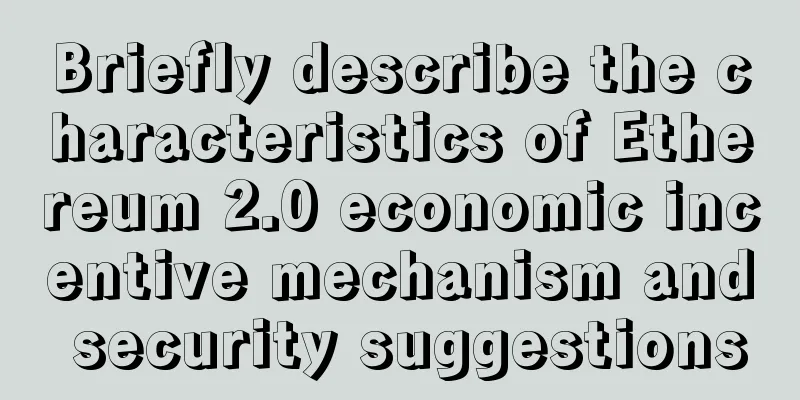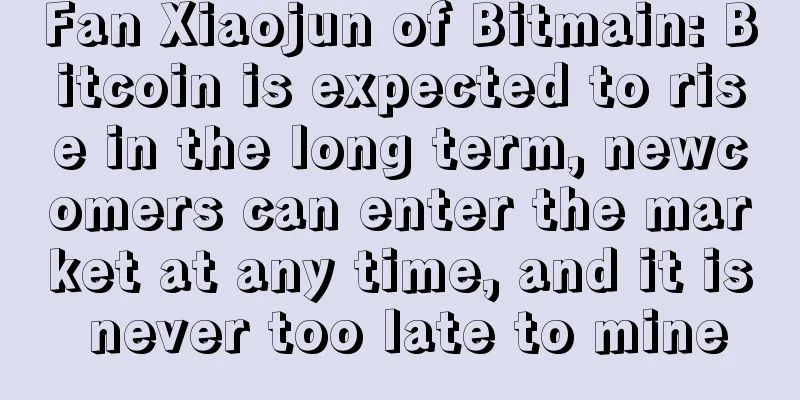Briefly describe the characteristics of Ethereum 2.0 economic incentive mechanism and security suggestions

|
Original title: "Viewpoint | A brief summary of the ETH 2.0 economic model analysis report" In March 2020, we received funding from MolochDAO to research the economic model of ETH 2.0. This investigation was originally in response to a call for proposals: Since then, we have been working hard to analyze the ETH 2.0 network and its PoS-based economic incentive mechanism. Our conclusions are based on our own research. We built an economic model to reflect the inputs and outputs of the ETH 2.0 network and interviewed many stakeholders representing the main players in the Ethereum ecosystem. We have compiled all of our findings into the following report: ETH 2.0 Economic Review: Analysis of Ethereum PoS Incentive Model We would like to thank MolochDAO, the people we spoke with, and the Ethereum Foundation for their support of this project. Special thanks to Danny Ryan, Barnabe Monnot, Trent Van Epps, and Vitalik Buterin for their comments and suggestions on the initial draft. While we highly recommend reading the full report, we’ve included a summary below. If anyone has any questions, please reach out to us on Twitter — @thomasborgers and @tehoban1 — PMs are welcome! The ETH 2.0 network upgrade is a gradual move towards the grand goal of the PoS consensus algorithm and incentive mechanism. In turn, the PoS incentive mechanism has a profound impact on the economic properties of the Ethereum network. The design of the PoS incentive mechanism is very complex - on the one hand, it is necessary to reward honest participants who verify transactions and finalize the historical state of the network, and on the other hand, punish those offline or malicious validators. In this paper, we use a sophisticated economic model and a new economic evaluation tool to define, measure, and analyze the cryptoeconomic security of ETH 2.0. First, to facilitate the study of the economic model of Eth2.0, we used Excel to build an economic model to explain the output of the ETH 2.0 system under current specifications and specific scenarios. Throughout the project, we gradually developed and used this model to calculate expectations and draw conclusions about validator income, costs, benefits, and currency issuance based on data. In the ETH 2.0 system, there are nearly 100 variables that have a significant impact on the output value. Through this model, we dynamically show the impact of ETH price changes and the total amount of ETH staked on validator income, highlighting the impact of variables on network security. We defined the level of economic security that ETH 2.0 Phase 0 must achieve using a series of assumptions around the cost of attacking the network. This level of security is meant to make the cost of an attack higher than the potential benefit of an attack, and to give ETH 2.0 Phase 0 the same level of security as ETH 1.0 (the current Ethereum blockchain). We identified two main categories of economic attack vectors. Each of these attack vectors has different variants and different levels of risk: Supermajority Attacks and Finality Attacks. In Phase 0, we focus primarily on attacks that are intended to destroy the network. We find that the network is at risk of these attacks in Phase 0, but we are more concerned about subsequent phases. Based on the historical price and hashrate of ETH, we estimate that a staking rate of 13.8% provides adequate security. The security of ETH 2.0 is tied to the amount of ETH staked, which itself is a function of returns. We built a model to understand the motivations of investors who are committed to high capital utilization. We call it RSAVY (Required Serenity Active Validator Return) model, which is used to determine the risk and cost issues of staking, and the corresponding required rate of return (RRR). Based on our results, we expect that in an optimized (endogenous and exogenous) network, the required rate of return (i.e., minimum rate of return) must be at least 3.3% before validators will consider joining the network. In a bearish but stable market environment, the required rate of return increases to 11.6%. In addition to calculating the required rate of return, the RSAVY model can also be used to outline the overall picture of the network in specific scenarios. In these scenarios, we use different parameters and come to some conclusions and suggestions, which are detailed below. in conclusion The PoS mechanism of ETH 2.0 is much more complicated than the PoW mechanism. ETH 2.0 is a highly complex and well-thought-out system. This system has been carefully designed and constructed, but it is difficult to understand from the perspective of a validator, resulting in uncertainty and unpredictability, making it more difficult for potential validators who seek capital efficiency to understand. suggestion Increasing the base reward factor to 128 and beyond: We acknowledge that increasing network costs helps improve network security, but with a base reward factor of only 64, we believe the cost the network pays for security is insufficient - it is wise to be cautious during the Ethereum network's transition to a PoS mechanism. |
>>: Today's Recommendation | Bitcoin's Second Half of 2020
Recommend
Analysis of the face of a woman with a sunken brow. Is it good or bad for a woman to have a sunken brow?
1. The face of a woman with a sunken forehead The...
SimonsChain uses quantitative strategies to leverage digital currency asset management and create the first smart investment advisory application in the cryptocurrency circle
In 2017, digital currency and blockchain graduall...
Palmistry Venus Belt Palmistry - Venus Belt
Palmistry Venus Belt, Palmistry - Venus Belt The ...
The tail of your eye shows your relationship with the opposite sex
Eyes are human's visual organs. In addition t...
Do cryptocurrency transactions need to be taxed?
From OK to Huobi, people have all kinds of specul...
Eris Industries and Ledger Partner to Provide Strong Security for Enterprise-Level Blockchain Services
Eris Industries has entered into a strategic part...
Blockchain could put Wall Street recordkeepers out of work
A U.S. Commodity Futures Trading Commission (CFTC...
What is the fate of a man with a thick lower lip?
What is the fate of a man with a thick lower lip?...
Bitcoin price breaks new high due to three main reasons
Golden Finance News - According to foreign media ...
Following the legalization of mining, Iran plans to introduce annual mining licenses
After legalizing digital currency mining activiti...
Body Palace and Life Palace_Face Analysis
"Ming Palace" is one of the twelve pala...
After Taproot, what’s next for Bitcoin?
Taproot, a privacy and scalability upgrade, the l...
Is it good for a man to have eyebrows connected together?
Men with connected eyebrows are particularly eloq...
What does a forked love line mean?
The heart line is also known as the love line. If...
Is it true that people with three white eyes are more likely to die in vain?
Three white eyes is a kind of eye feature in the ...









